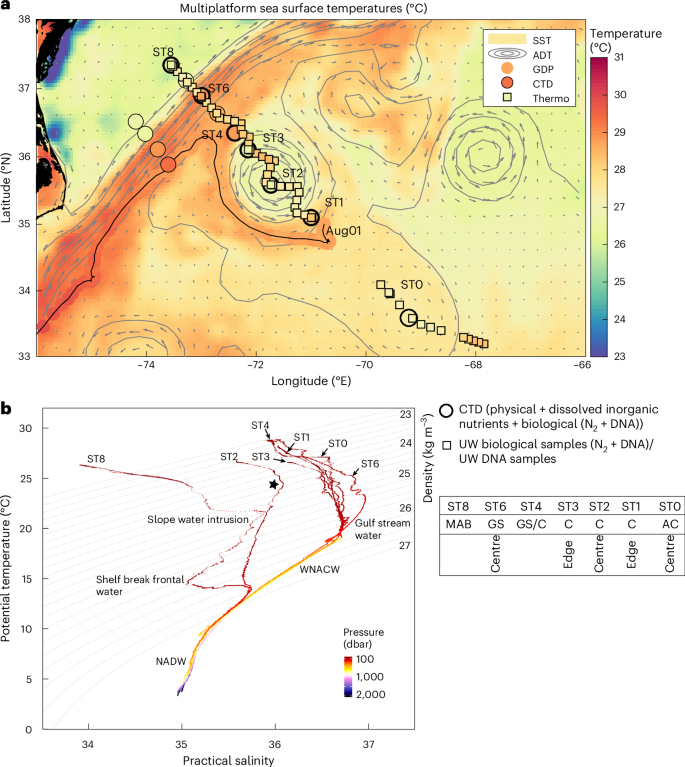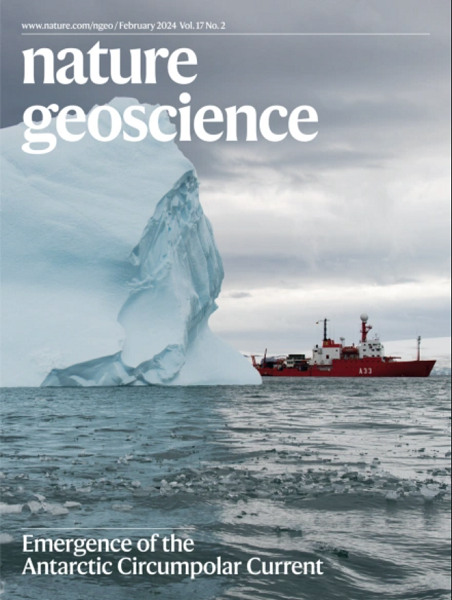湾流涡带重氮营养体支持的北大西洋固氮作用
IF 16.1
1区 地球科学
Q1 GEOSCIENCES, MULTIDISCIPLINARY
引用次数: 0
摘要
中尺度海洋漩涡有助于重新分配浮游生物生长所需的资源。然而,由于中尺度洋流具有捕捉流体的能力,它们也会隔离浮游生物群落,使其受到快速变化的环境条件的影响。固定二氮(N2)的重氮营养体是浮游生物群落的关键成员,可提供活性氮,尤其是在亚热带大涡旋等营养贫乏地区。然而,与大洋区域的大尺度动态相比,人们对以当地特定环境条件为特征的中尺度结构如何影响重氮营养盐的分布和代谢反应的了解仍然有限。在这里,我们研究了湾流和两个相关漩涡横断面上的遗传重氮营养体多样性和氮固定率,湾流和两个相关漩涡是一个中尺度活动剧烈的区域,因其在北大西洋环流营养物质输送中的重要作用而闻名。我们的研究表明,漩涡边缘是重氮营养体活动的热点,漩涡之间具有潜在的群落连通性。利用长期的中尺度漩涡数据库,我们对漩涡内的 N2 固定率进行了量化,其固定率比环境水域高出 17 倍,总体上为该区域提供了约 21 µmol N m-2 yr-1。我们的研究结果表明,在更广泛的海洋氮循环中,中尺度漩涡是活性氮产生的热点。本文章由计算机程序翻译,如有差异,请以英文原文为准。


Nitrogen fixation in the North Atlantic supported by Gulf Stream eddy-borne diazotrophs
Mesoscale oceanic eddies contribute to the redistribution of resources needed for plankton to thrive. However, due to their fluid-trapping capacity, they can also isolate plankton communities, subjecting them to rapidly changing environmental conditions. Diazotrophs, which fix dinitrogen (N2), are key members of the plankton community, providing reactive nitrogen, particularly in large nutrient-depleted regions such as subtropical gyres. However, there is still limited knowledge about how mesoscale structures characterized by specific local environmental conditions can affect the distribution and metabolic response of diazotrophs when compared with the large-scale dynamics of an oceanic region. Here we investigated genetic diazotroph diversity and N2 fixation rates in a transect across the Gulf Stream and two associated eddies, a region with intense mesoscale activity known for its important role in nutrient transport into the North Atlantic Gyre. We show that eddy edges are hotspots for diazotroph activity with potential community connectivity between eddies. Using a long-term mesoscale eddy database, we quantified N2 fixation rates as up to 17 times higher within eddies than in ambient waters, overall providing ~21 µmol N m−2 yr−1 to the region. Our results indicate that mesoscale eddies are hotspots of reactive nitrogen production within the broader marine nitrogen cycle. Nitrogen fixation by diazotrophs within North Atlantic eddies, especially near the edges of the mesoscale structures, is a key component of the North Atlantic marine nitrogen cycle, according to an analysis of genetic and past eddy activity data.
求助全文
通过发布文献求助,成功后即可免费获取论文全文。
去求助
来源期刊

Nature Geoscience
地学-地球科学综合
CiteScore
26.70
自引率
1.60%
发文量
187
审稿时长
3.3 months
期刊介绍:
Nature Geoscience is a monthly interdisciplinary journal that gathers top-tier research spanning Earth Sciences and related fields.
The journal covers all geoscience disciplines, including fieldwork, modeling, and theoretical studies.
Topics include atmospheric science, biogeochemistry, climate science, geobiology, geochemistry, geoinformatics, remote sensing, geology, geomagnetism, paleomagnetism, geomorphology, geophysics, glaciology, hydrology, limnology, mineralogy, oceanography, paleontology, paleoclimatology, paleoceanography, petrology, planetary science, seismology, space physics, tectonics, and volcanology.
Nature Geoscience upholds its commitment to publishing significant, high-quality Earth Sciences research through fair, rapid, and rigorous peer review, overseen by a team of full-time professional editors.
 求助内容:
求助内容: 应助结果提醒方式:
应助结果提醒方式:


